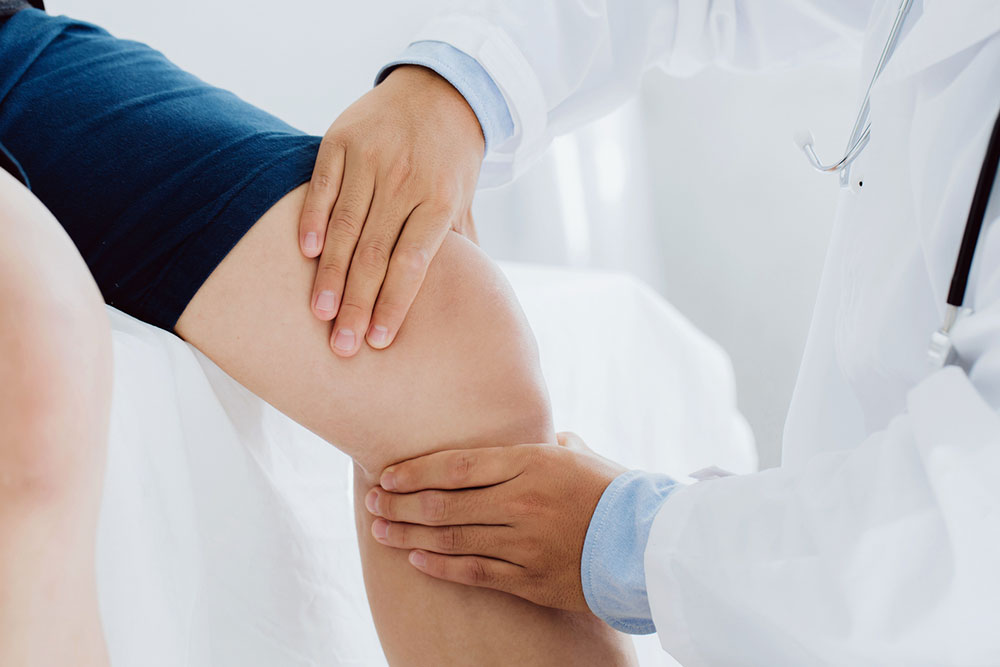10 warning signs of osteoporosis

Osteoporosis is a condition that weakens the bones by causing them to become thinner over time. It is commonly associated with aging, as the old bone tissue breaks down faster than it is created. This results in fragile bones, which is what we refer to as osteoporosis. It is often called the “silent disease” as it doesn’t usually show any symptoms in the early stages. But as the disease progresses, some indications of osteoporosis may include:
1. Low bone density
Low bone mineral density is an early warning sign of osteoporosis. When caused by loss of bone, this is also referred to as osteopenia. Low mineral content in the bones leads to weaker bones. However, not everyone with osteopenia develops osteoporosis.
Individuals with osteopenia must keep a close eye on other symptoms of osteoporosis that may arise. Making lifestyle changes to prevent further bone loss may also be beneficial. These include following a calcium treatment and a balanced meal plan, exercising regularly, and getting enough vitamin D.
2. Bone fractures
As the bones weaken, they become more prone to breakage and fractures, even from mild trauma like a small bump, coughing, or bending to pick something up. This is one of the most prominent warning signs of osteoporosis. Although fractures can occur in any bone, the most common locations for bone breakage include the hip, spine, and wrist. Research suggests that bone fractures can increase one’s risk of disability or death.
3. Losing height
While it is common to stoop and lose height as one ages, losing more than 1.5 inches may be a sign of osteoporosis. This generally occurs due to fragile spinal vertebrae and compression fractures (which occur when the bones press and collapse against each other).
4. Curved upper back
Another common warning sign is a curved or hunched upper back. This is also known as dowager’s hump or dorsal kyphosis. This is also a result of compression fractures.
While a hunched back may be a common sign of osteoporosis, it is important to note that it may also indicate other medical conditions such as Scheuermann’s Disease, Ehlers-Danlos syndrome, or disk degeneration.
5. Sudden back or neck pain
Compression fractures can cause sudden and sharp pain in the middle or lower back. It is advisable to consult a doctor in case of unexplained pain or if the pain is accompanied by other symptoms of osteoporosis.
6. Gastrointestinal (GI) issues
GI issues may also be a sign of osteoporosis. They may occur due to lumbar fractures causing spinal compression, as they reduce the space in the abdominal cavity. Some common symptoms include constipation, bloating, loss of appetite, feeling full quickly, and stomach pain.
7. Shortness of breath
As the spine compresses due to bone loss or fractures, it may reduce the lung’s ability to function well. This may lead to shortness of breath or wheezing. Since this symptom may also be associated with other serious medical conditions, it is recommended to consult a healthcare professional promptly.
8. Dental issues
Dental issues are also commonly associated with osteoporosis. The most frequently seen symptom is receding gums, which may occur as the jaw begins to lose bone. Other symptoms also include loose teeth and loose-fitting dentures. If any of these symptoms appear, it may be time to consult a healthcare provider and discuss the need for a bone density scan and other risk factors.
9. Weaker grip strength
Research also suggests that weaker grip strength may be associated with low bone mineral density, becoming an early warning sign of osteoporosis. Decreased grip strength may also increase the likelihood of falling.
10. Weak and brittle fingernails
Nail strength is another indicator of bone health. If one’s fingernails are weak and break regularly, it may be a warning sign of osteoporosis. However, weak and brittle nails could also result from other factors, such as exposure to extremely hot or cold temperatures, regular use of nail paint remover or acrylic nails, or submersion in water for long periods.
Along with the warning signs of osteoporosis, one must also know their risk levels. Some of these risk factors include:
1. Age
Bone loss is common with age. The bone is made of living tissue that constantly breaks down and rebuilds. As one ages, the body loses the ability to keep up with the rate of tissue breakdown, leading to a reduction in bone density. As a result of this, those over the age of 50 are at a higher risk of developing osteoporosis.
2. Gender
Women are four times more likely to develop osteoporosis in comparison to men. This risk for osteoporosis increases with menopause, as experts believe that women lose 20 percent or more bone density within the first 10 years after menopause.
3. Poor eating habits
Not getting enough protein, calcium, and vitamin D can increase the risk of osteoporosis.
4. Breast cancer
Breast cancer treatment may trigger the early onset of menopause. This can increase one’s likelihood of developing osteoporosis as well.
5. Physical inactivity
Exercising regularly can help build stronger muscles and bones. On the other hand, an inactive lifestyle can lead to weaker bones prone to breakage.
6. Family history
Those with a family history of osteoporosis have a greater risk of developing the condition, especially if the parent has had a hip fracture.
7. Medical conditions
Having certain medical conditions can also increase one’s risk of osteoporosis. Some of them include kidney failure, vitamin D deficiency, diabetes, hyperthyroidism, hyperparathyroidism, rheumatoid arthritis, dementia, cystic fibrosis, sickle cell disease, multiple myeloma, ankylosing spondylitis, or malabsorption due to inflammatory bowel disease or celiac disease.
Osteoporosis symptoms can cause a lot of pain. Knowing the risk factors and common warning signs can help one seek help in a timely manner. It is important to consult a doctor immediately in case of severe pain that interferes with the quality of one’s life.









